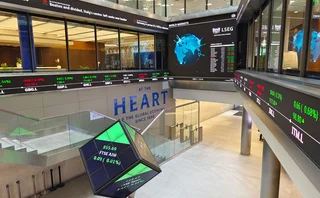
Exchange of the year: CME Group
Chicago exchange found fixes for five-year issuance gap in US Treasury bonds

Risk Awards 2016
In late 2014, bond traders noticed a discrepancy in the pricing of the CME's flagship US Treasury bond futures. At one point, the price of 30-year Treasury contracts expiring in June 2015 gapped more than 11% higher than those expiring in March. The discrepancy didn't reflect a sudden and dramatic shift in US rate expectations, but rather a distortion in the underlying Treasury market – a hangover from a five-year gap in 30-year bond issuance by the US debt management office between 2001 and 2006.
Because the contracts are settled physically, that presented the market with a significant challenge. The party on the short side of the trade has a choice of which T-bonds to deliver, with a bias towards delivering the cheapest – those with the shortest remaining maturity. In the March-to-June 2015 roll for 30-year US Treasury futures, the difference in term to maturity of the cheapest-to-deliver bonds between the previous and upcoming contract was five whole years – a huge jump from the usual three months.
With the roll date for the futures approaching, CME acted fast to help the contract's users.
"The market presented a number of challenges and we faced them with our clients and created new solutions and innovations to address those challenges," says Sean Tully, senior managing director of financial and over-the-counter products at CME Group in Chicago.
Many investors seek to maintain an on-the-run short or long exposure to US Treasury futures through calendar spread contracts, selling them to stay long or buying them to stay short. In response to the heightened roll risk between the March and June expiries, CME unveiled an additional calendar spread, which allowed investors to take a 3:2 exposure across the expiries, rather than the usual 1:1 ratio.
An investor using the 1:1 ratio would have to do a significant amount of work to get the final balance in its risk exposure right. With the exposure much higher in the March to June contract, the 1:1 ratio would have required a far greater number of outright transactions to achieve the same net risk exposure; a position in 1,000 of the March contracts would require a long position in 665 of the new June contracts.
The numbers tell the story of the market's receptiveness: almost 800,000 contracts with the 3:2 ratio traded during the March roll, making up 63% of Globex volumes and 52% of overall trade volumes.
This is a very significant contract in the single most liquid government bond market in the world
Sean Tully, CME Group
Some would argue such innovations have come at a price, though. Members of many major exchanges grumble that fees – whether for trading, clearing or data – crept up across the board last year. CME Group chief executive Phupinder Gill acknowledges CME was no exception in this regard, but argues the rises were necessary – and kept to a minimum.
"Fees are one of the concerns folks have with exchanges as large as ourselves, and we have been ultra-sensitive to that. When we raise fees, we do it with sensitivity of the types of products we deliver, and the quality of the risk exposure coverage we give our client base. Any increase in fees is so we can invest in technology and other solutions to bring the bid/offer spread down, which creates the liquid market that CME group has," says Gill.
Navigating the five-year gap in Treasury issuance meant reaching out to users of the contract to educate the market on the implications, and get feedback on the exchange's proposed solution. CME did so via webinars, marketing material and more direct interaction.
"It was a completely new function, and we had to go out and educate the market. This is a very significant contract in the single most liquid government bond market in the world. It was very important that participants knew how this roll was going to occur and that they were ready for the change relative to the duration. This has never happened before, and we went out and provided the technology customers needed," says Tully.
Following the closure of the bourse's open-outcry trading pits, market participants also indicated they would prefer to define their own Treasury spread ratio orders on CME's Globex platform. The result was the August 2015 release of a new user-defined spread contract, a format that attracted a volume of 80,000 in the first September-to-December roll.
"It allowed our customers to trade our product exactly the way they want to trade it. So while the amount of roll done on the floor was relatively small, we wanted to make sure each participant got the experience they wanted relative to the way they trade, so we made sure we could replicate that floor experience electronically," says Tully.
The Treasury issuance gap resulted in a situation where the existing TY 10-year Note future had a cheapest-to-deliver bond with remaining maturity of seven years, and then following the jump of the gap, the cheapest to deliver for the classic bond futures was 20 years, resulting in requests to launch a new contract somewhere in the middle.
In response, the bourse announced in October it would launch a new flavour of 10-year US Treasury note futures and options in early 2016, allowing delivery of 10-year US Treasury notes with remaining term to maturity of at least nine years and five months and not more than 10 years. For existing futures, delivery is allowed for notes with remaining terms of at least six years and six months.
Only users who have a paid subscription or are part of a corporate subscription are able to print or copy content.
To access these options, along with all other subscription benefits, please contact info@risk.net or view our subscription options here: http://subscriptions.risk.net/subscribe
You are currently unable to print this content. Please contact info@risk.net to find out more.
You are currently unable to copy this content. Please contact info@risk.net to find out more.
Copyright Infopro Digital Limited. All rights reserved.
As outlined in our terms and conditions, https://www.infopro-digital.com/terms-and-conditions/subscriptions/ (point 2.4), printing is limited to a single copy.
If you would like to purchase additional rights please email info@risk.net
Copyright Infopro Digital Limited. All rights reserved.
You may share this content using our article tools. As outlined in our terms and conditions, https://www.infopro-digital.com/terms-and-conditions/subscriptions/ (clause 2.4), an Authorised User may only make one copy of the materials for their own personal use. You must also comply with the restrictions in clause 2.5.
If you would like to purchase additional rights please email info@risk.net
More on Awards
Clearing house of the year: LCH
Risk Awards 2025: LCH outshines rivals in its commitment to innovation and co-operation with clearing members
Best use of machine learning/AI: CompatibL
CompatibL’s groundbreaking use of LLMs for automated trade entry earned the Best use of machine learning/AI award at the 2025 Risk Markets Technology Awards, redefining speed and reliability in what-if analytics
Markets Technology Awards 2025 winners’ review
Vendors jockeying for position in this year’s MTAs, as banks and regulators take aim at counterparty blind spots
Equity derivatives house of the year: Bank of America
Risk Awards 2025: Bank gains plaudits – and profits – with enhanced product range, including new variants of short-vol structures and equity dispersion
Law firm of the year: Linklaters
Risk Awards 2025: Law firm’s work helped buttress markets for credit derivatives, clearing and digital assets
Derivatives house of the year: UBS
Risk Awards 2025: Mega-merger expected to add $1 billion to markets revenues, via 30 integration projects
Interest rate derivatives house of the year: JP Morgan
Risk Awards 2025: Steepener hedges and Spire novations helped clients navigate shifting rates regime
Currency derivatives house of the year: UBS
Risk Awards 2025: Access to wealth management client base helped Swiss bank to recycle volatility and provide accurate pricing for a range of FX structures







